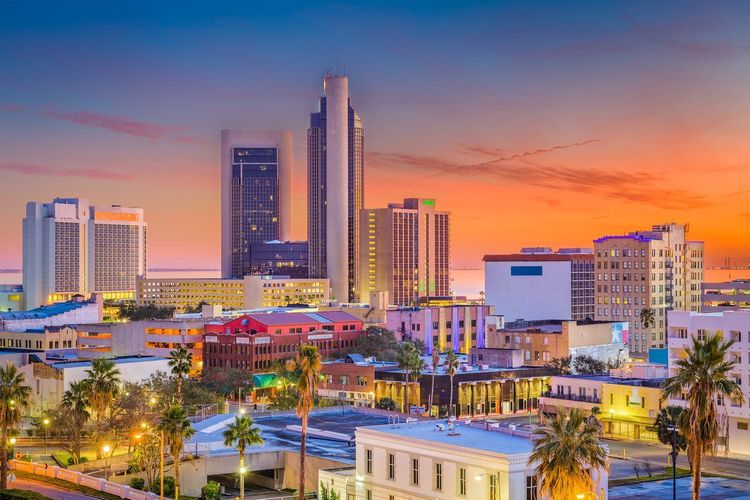Are you planning to relocate to the city known as the Sparkling City by the Sea? It's high time to look at the pros and cons of living in Corpus Christi, TX. It is time to find out whether this is a perfect place for you, at least when it comes to the cost of living, lifestyle, and other essentials.
Quick Facts to Know Before Moving to Corpus Christi TX

- Population: 326,586 (2020 Census)
- Median Home Cost: $158,800 (Zillow, 2021)
- Average Commute: 20.2 minutes (U.S. Census Bureau)
- Top Employers: Corpus Christi ISD, H-E-B, Driscoll Children's Hospital
Pros of Living in Corpus Christi
1. Easy Beach Access
One of the biggest perks of life in Corpus Christi? Those stunning Gulf Coast beaches are proper in your backyard. Take the sunbath on Padre Island, ride the water bicycles in Corpus Christi Bay or visit Padre Island National Seashore. Did you know that Brevard County has more than 100 miles of coastline? That means there is no shortage of sandy adventures.
2. Deep History
The Corpus Christi Museum of Science and History includes the Native American Culture, the Texas Revolution, and more. History lovers will appreciate the carefully renovated buildings in the downtown area and fans of naval history will be enthralled by the USS Lexington Museum.
3. Diverse Population
The city is culturally diverse with colourful festivities, good food, and a good neighbourly feeling. Buccaneer Days carnival, running annually for about twelve days, and a cultural Mexican event typically known as Día de los Muertos are among the notable events.
4. Affordable Housing Market
The median home price is considerably below the national average, meaning owning a home is affordable to many people. Also, with a wide range of neighbourhoods to select from, including pretty historic areas, friendly suburban areas, and relaxed beach towns, you will secure your dream neighbourhood.
5. Strong Education
The city boasts good public and private schools, colleges, and universities, including Texas A&M University-Corpus Christi and Del Mar College. Families like the support offered to education within communities, and there is a lot of support in infrastructure and other co-curricular activities for learners of all ages.
6. Natural Beauty
Besides the sandy shore, Corpus Christi is blessed with other natural attractions. Right at the centre of this habitat lies the Oso Bay Wetlands Preserve, perfect for a quiet hike with the chance to see beautiful birds and wildlife. Mustang Island and Aransas National Wildlife Refuge are nearby and famous for fishing, kayaking, and enjoying the beauty of the sea and wildlife.
Cons of Living in Corpus Christi
1. High Humidity
South Texas summers are hot and humid. Corpus Christi's coastal location means sticky, muggy days are the norm from June through September. If you're not a fan of heat and humidity, be prepared to crank the AC or escape to indoor activities during the peak summer months.
2. Dirty Areas
Although a large portion of Corpus Christi is clean and well taken care of, some areas of the city still have problems with trash, graffiti, and cleanliness. Some issues have been noted in North Beach, especially with washing the sand and the streets. The city is trying to solve these problems, but sometimes, the process seems rather sluggish.
3. Job Shortages in Niche Industries
Corpus Christi's economy is largely driven by tourism, healthcare, and the oil/gas industry. You may face limited job opportunities if your career falls outside these major sectors. Creative professionals, tech workers, and those in highly specialised fields may need to be open to commuting or working remotely.
4. Limited Public Transportation
While Corpus Christi does have a public bus system, it's not as extensive or reliable as in larger cities. Most residents rely on personal vehicles to get around, which can mean battling traffic during peak times. If you don't have a car or prefer public transit, be prepared for longer commute times and less flexibility.
5. High Crime Rates
The crime rates in Corpus Christi are higher than the standard crime rates across the United States; property crimes and theft. Although the violent crime rate is comparatively low, people have to protect their homes and cars against potential thieves. The safety of neighbourhoods may be higher or lower, so it is necessary to get some information about crime rates and ask people who live there.
6. Low Government Spending
In recent years, the government of Corpus Christi has been facing the issue of limited revenues, which means the lack of funds to meet the city's needs, including public services, transportation, and community programmes, to mention but a few. Citizens may experience the effects in the sense of poor road rehabilitation, fewer park renovations, or less funding for libraries and recreational facilities.
7. High Poverty Rate

Even though it has a low cost of living, the poverty rate in Corpus Christi is higher than that of the rest of the country. There is considerable income disparity, and most people cannot make a decent income to sustain their household. This may increase the rate of crimes, hence affecting social services and creating a higher gap between the haves and the have-nots in the city.
8. Vulnerability to Hurricanes
Corpus Christi is vulnerable to hurricanes and tropical storms like other coastal cities. The city has faced devastating damage from past storms, notably Hurricane Harvey in 2017. Residents must be prepared with emergency plans, supplies, and insurance coverage. Flood-prone areas may face additional challenges with evacuation and property damage.
9. High Property Insurance Rates
Due to the risk of hurricanes and flooding, property insurance rates in Corpus Christi tend to be higher than in inland cities. Homeowners and renters alike should budget for increased insurance premiums to protect against potential storm damage. Flood insurance may be required in certain areas, adding to the overall cost of living.
Best Neighborhoods to Live in Corpus Christi TX
- Calallen: Family-friendly suburb with top-rated schools
- Flour Bluff: Laid-back coastal community near beaches and parks
- Lamar Park: Historic neighborhood with charming homes and tree-lined streets
- Padre Island: Relaxed beach lifestyle with access to water sports and nature
Cost of Living in Corpus Christi TX
Housing costs in Corpus Christi are 22% cheaper on average than the national average, and utility costs are 16% more expensive. Public transport costs, such as bus fares and gasoline, are 6% cheaper than the national average. However, remember that transportation costs may be higher if you rely on a personal vehicle.
What's the Population of Corpus Christi?
As of the 2020 Census, Corpus Christi's population is 317,863. The city has seen steady growth over the past decade, with a 9.6% increase since 2010.
How Fast Can You Commute in Corpus Christi, TX?

The average commute time in Corpus Christi is 20.2 minutes, lower than the national average of 26.9 minutes. However, traffic congestion can be challenging during peak times, particularly on significant thoroughfares like S.P.I.D. (South Padre Island Drive).
What is the Weather Like in Corpus Christi, TX?
Corpus Christi enjoys a humid subtropical climate with hot summers and mild winters. Average temperatures range from the mid-50s in January to the low 90s in August. The city receives about 29 inches of rainfall annually, with occasional hurricanes and tropical storms during the summer and fall.
Conclusion
Living in Corpus Christi has a unique blend of coastal charm, cultural diversity, and affordability that's hard to find in other beach cities. While the hot and humid summers, higher crime rates, and limited job opportunities in specific industries may be deal-breakers for some, many residents find that the easy beach access, strong sense of community, and lower cost of living make it all worthwhile.
The decision to move to Corpus Christi depends on your priorities, lifestyle, and personal preferences. We hope this honest look at the pros and cons has given you a clearer picture of life in the Sparkling City by the Sea. Happy exploring!
Also Read: What Cities are Closest to the Grand Canyon




